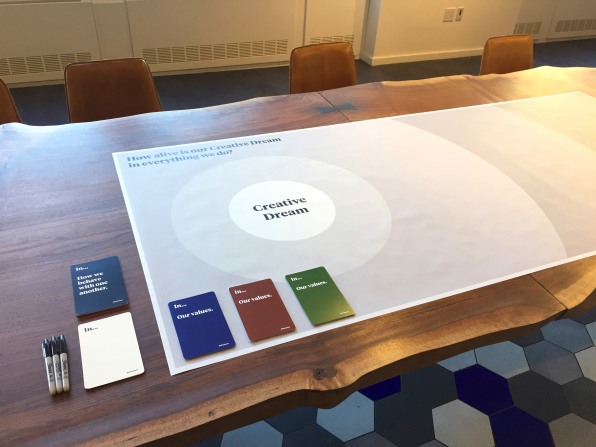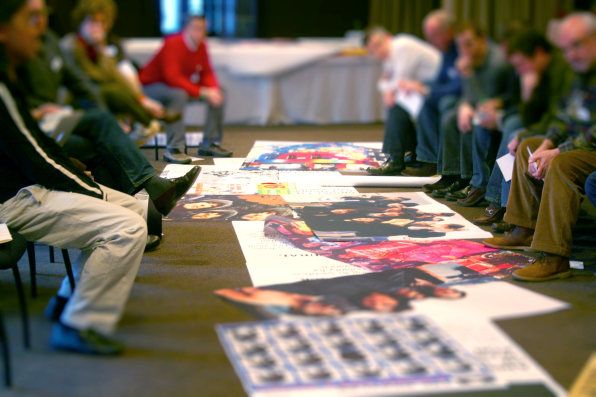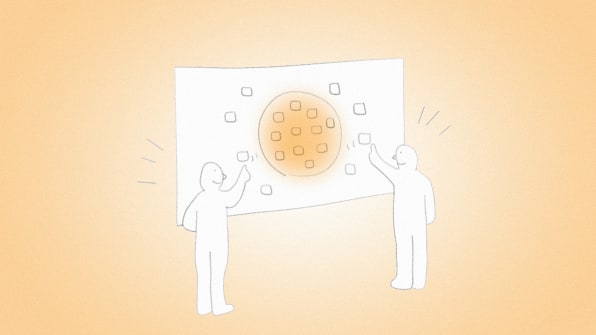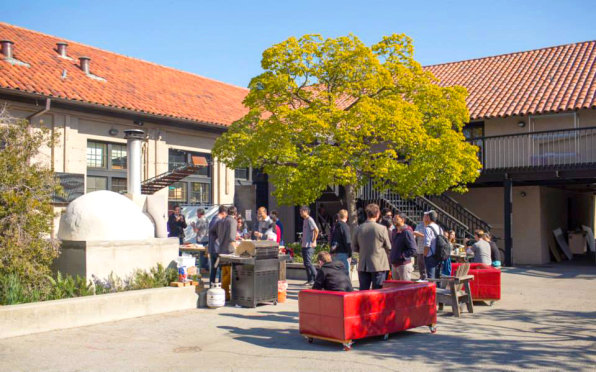Using playfulness can help engage employees and give them more buy-in to changes in the workplace.

This year, our lifestyles and ways of working were altered dramatically by COVID-19. Offices shut down, people scattered to remote outposts, and anxiety about the future was ever-present.
With a vaccine now being deployed, we can finally start to imagine what a return to work might look like. And yet any number of disruptive forces might still lie ahead, and it will be imperative for individuals, teams, and organizations to be open to transformation.
This is a challenge even under the best of circumstances. People generally resist change, or at least the uncertainty it creates, and have a hard time considering alternative realities. But using playfulness as a framework for thinking about transition can give people an easier entry point. Designing with playfulness—a curious and experimental spirit—can help engage employees and give them more buy-in to the changes. Here are three ways to start.
Playfulness helps overcome a fear of change
Playfulness lowers the stakes and provides permission to take risks, ultimately helping to overcome a sense of fear and resistance to change.
I once was part of a team working with an iconic fashion brand led by a legendary creative founder. The company was undergoing a leadership transition, and because of this, there was tension among the executives between those who believed the fashion company should be led by a creative and those who thought they needed a more business-focused leader.

When we introduced the activity to the business executives, they initially seemed puzzled. A card game at an executive meeting?
However, the inviting and informal nature of the card game helped them overcome the discomfort, and provided the space for them to share their true thoughts about the company’s direction. The game revealed that while there was tension, they were mostly aligned. It also clarified where their mindsets, values, and visions diverged. From there, the leadership team was able to work through the discrepancies together.
It doesn’t have to happen through a game. Sometimes playfulness is expressed more intangibly, in an attitude or approach. Even designing conditions that encourage openness to creative, experimental experiences more subtly—such as through your use of language or visuals—can lower the pressure and invite people to engage in new ways.

Playfulness encourages creative thinking
Playfulness opens the door to new experiences that are more sensory and impactful than reading a presentation. This provides a fresh perspective and encourages creative thinking.
In his memoir Onward, Starbucks CEO Howard Schultz recalls an executive off-site meeting soon after resuming his duties as CEO in 2008. When his leadership team walked into the room, they found large-scale banners of the Beatles laid throughout. They were each given iPod Shuffles loaded with the Beatles’ canon.

The unconventional multisensory meeting set the stage for a conversation about what it took to reinvent an icon—whether a timeless band like the Beatles or a beloved brand like Starbucks. Seeing their company in a new way allowed them to reframe their business challenges and set off a company transformation toward a grander vision of what Starbucks could become, the international success it is today.

Playfulness unites us
Particularly for teams and organizations, playful moments foster stronger bonds and a shared sense of accountability. Undergoing transformation requires trust and buy-in to be successful.
One of my most impactful experiences witnessing the power of playfulness occurred while I was a graduate student in the design program at Stanford. While the program had been founded in 1958, it was completely reimagined in 2015.
Professors organized a series of workshops with key stakeholders within the larger design community at the university. One workshop aimed to determine what could and couldn’t be changed about the program, using the game of Jenga as an inspiration.

In the face of a daunting task like redesigning a nearly 60-year-old research and education system, playfulness was a powerful tool. Even with many people involved—faculty, students, administrators—this whiteboard exercise allowed stakeholders to play a participatory role in transformation and to hear each others’ opinions. In 2017, they completed the redesign of the program, now called the Stanford Design Impact Program.

The power of playfulness
The writer David Foster Wallace gave a now-famous commencement speech in which he told a story about two fish swimming. At one point they pass an older fish who asks, “How’s the water?” The two young fish swim on for a bit, and eventually one of them looks over at the other and says, “What the hell is water?”
In my design work with clients and partners, even in traditionally corporate environments, my goal is to help people see not just the water, but the air, land, and everything else around them. I want people to conceive of what’s possible beyond what they’ve always known.
I’ve found that a playful approach can help build awareness of possibilities and set in motion a transformation from a current product, service, or culture. Playfulness is powerful. It helps people ease into change. It permits us to be experimental and to think about alternative states of being. It reveals the various perspectives within a group, and creates the conditions to work toward alignment.
Following a challenging year like 2020, when it’s become clear that there’s so much to transform, playfulness can help us go beyond our water.
Takuo Fukuda is a creative director at SYPartners.
Note: Changes to the Full-Text RSS free service
"tactic" - Google News
December 23, 2020 at 07:00PM
https://ift.tt/3ax5L4e
The surprising tactic that could help workplaces recover in 2021 - Fast Company
"tactic" - Google News
https://ift.tt/2NLbO9d
Shoes Man Tutorial
Pos News Update
Meme Update
Korean Entertainment News
Japan News Update
Bagikan Berita Ini














0 Response to "The surprising tactic that could help workplaces recover in 2021 - Fast Company"
Post a Comment